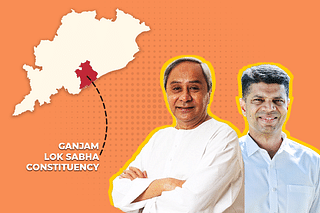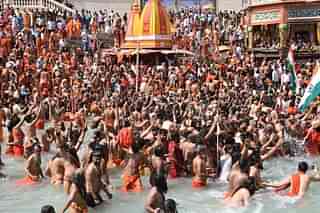North East
How A Small Tribe In Tripura Worships Shree Ram And Lead Their Sanatani Lives
Jaideep Mazumdar
Apr 06, 2024, 06:00 AM | Updated 12:27 PM IST
Save & read from anywhere!
Bookmark stories for easy access on any device or the Swarajya app.
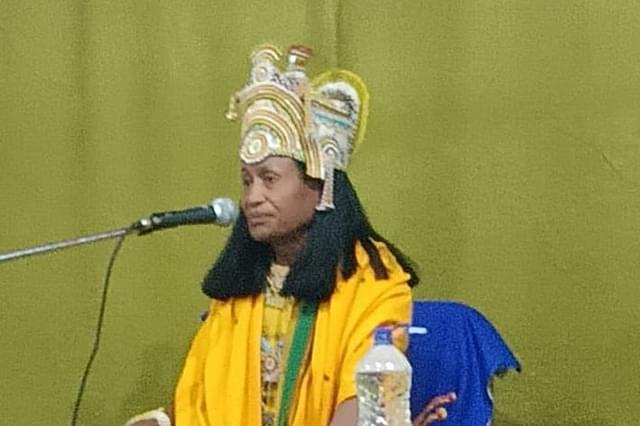
In the hills of eastern Tripura bordering Mizoram and Bangladesh, a small tribe has reimagined their Sanatani roots and have developed a unique system of worshipping Shree Ram, conducting themselves and pursuing spirituality.
The founding of this Sanatan revivalist movement, named Satya Sanatan Dharma Mandal, was triggered by aggressive evangelism of Christian missionaries.
Using allurements and various forms of coercion — even threats and physical violence — the missionaries started converting a large number of Brus to Christianity. Brus who had migrated to Mizoram became particularly vulnerable in that Christian-majority state.
That was when a young lad of the community, who was a devout Hindu, realised the need to get the community organised and united under a well-structured religious order. This, he realised, was the only effective way to resist the onslaught of the missionaries.
The young man, Manoram Bru, also realised that Hinduism was very disorganised with no fixed code for religious rituals and practices. That made the largely illiterate tribals vulnerable to vicious disinformation campaigns against Sanatan Dharma by missionaries.
Manoram Bru launched a religious campaign amongst his people emphasising the fact that though the Brus had their own indigenous deities and worshipped nature, they are part of the Sanatan Dharma.
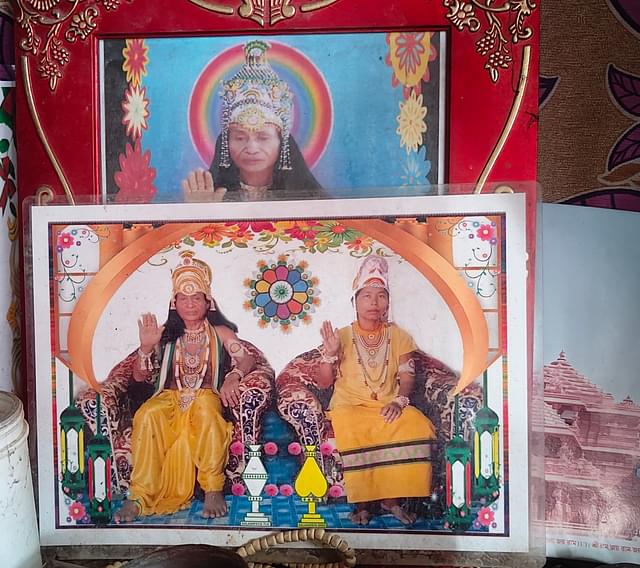
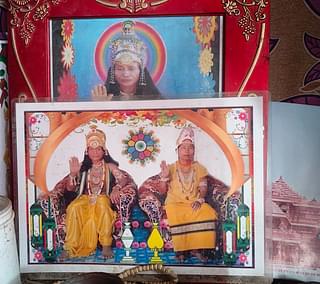
“Our parampara is Sanatan Dharma, which is the oldest faith on earth. Over time, we strayed and we moved away from Ishwar. To us, Ishwar is the Supreme Being. Most of us worship Devatas and Devis, but not Ishwar who is the sole (eka) Niranjan. He is the Sanatan Ishwar,” Jatindra Reang, the principal spokesperson of the Satya Sanatan Dharma Mandal, told Swarajya.
Reang said that the ancient traditions, culture, religious and social practices of the Brus were similar to those of the Sanatan Dharma. Manoram Bru spread this important message among his community members and convinced them to return to the Sanatan fold.
Manoram Bru initiated the practice of worshipping Shree Ram. Because, explained Reang, Ram is the Adipurush (primordial being), anantaguna (repository of virtues), Brahmanya, omniscient and omnipotent, Jagatguru, Mahadev, mahapurush, shahvata (eternal), tripurte (manifestation of the Trinity) and trilokatmane (lord of the three worlds).
All these qualities make Shree Ram a prime and powerful deity, Reang asserted. And that is why Manoram Bru decided to set up Ram mandirs all over the Bru-inhabited hills.
The first Ram mandir was set up at Manikpur under Paschim Malidhar gram panchayat of Dhalai district’s Chawmanu administrative block. Reang stays in the small town of Chawmanu.
Today, there are 30 Ram mandirs in the Dhalai, Unakoti, Gomati and North and South Tripura districts of Tripura inhabited by Brus. Five more are under construction.
Manoram Bru is fondly called Monu by the followers of the sect he has established. He goes by the formal name of ‘Manoram Bru Sanatan Bagra’ and now lives at Naisinghpara that falls under the Kanchanpur sub-division of North Tripura district. That also serves as the headquarters of the sect.
Stratified Sect
The followers of the sect are stratified into various categories based on their knowledge of Sanatan Dharma and on their own sect.
A child born into a Sanatani family has to be initiated and inducted into the Satya Sanatan Dharma Mandal. The process is simple: Monu’s bakya (prayers to Bhagwan Ram and his teachings) are whispered into the ears of the child, who is also bathed with water blessed by ‘Monu’.
Once this is done, the child is officially part of the Satya Sanatan Dharma Mandal and is a Lugo (novice).
All lugos are then schooled in the teachings of ‘Monu’, the Vedas, Upanishads, Gita, Ramayan and Mahabharat as well as the rituals and rules governing the sect. The lugos also learn from two religious books written by ‘Monu’ — the Smaikri Ni Dustur and the Aing Dustur Boi.
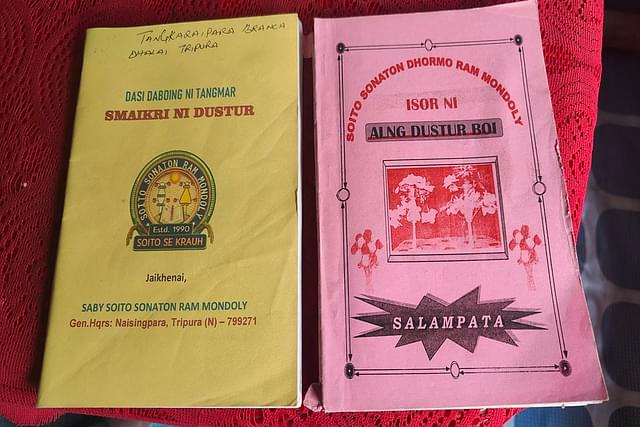
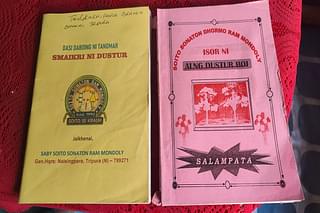
A lugo has to then sit for an examination to become a jawan. The exam — written as well as viva voce — is conducted by senior members of the order designated by ‘Monu’.
After passing this examination, a jawan becomes a sampurna jawan. After a few years during which his/her conduct is observed by senior members of the sect, a sampurna jawan is allowed to take another written examination and sit for an interview to become a ‘dasi’ or ‘daboing’. Males are known as dasi while females are called daboing.
Dasis and Daboings, after further religious studies and on passing scrutiny of their conduct by community elders, can take the next examination and interview to become a Sichu.
The minimum pass mark for an examination is 50. This examination is held once a year and if a dasi/daboing cannot pass, he/she has to wait another year to take the exam.
This process is repeated at each stage and a sichu becomes a mahanta and then a dharmaguru. The interviews held for promoting dasis/daboings to sichu, the sichu to mahanta and the mahanta to dharmaguru are conducted personally by ‘Monu’.
There are, at present 12 sichus, eight mahantas and five dharmagurus, and this reflects the tough process of promotion from one stage to the next.
Dress Code
During religious functions and community gatherings, or during weddings and other events, the various categories of devotees wear differently-coloured ceremonial attires.
The males among jawans and sampurna jawans wear white the females among them wear green, dasis and dabings wear blue dresses, sichus wear black and mahantas and dharmagurus wear distinct shades of saffron.
Also, one has to be a dasi or daboing to wear a rudraksha mala. A tulsi mala can be worn by all categories of devotees while jawans and sampurna jawans can wear the ved mala. The most coveted is the satya mala that is given by ‘Monu’ to select devotees across all categories.
Code Of Conduct
All members of the Satya Sanatan Dharma Mandal, which is also called Ram Mandali since the primary deity who is worshipped is Shree Ram, have to adhere to a strict code of conduct.
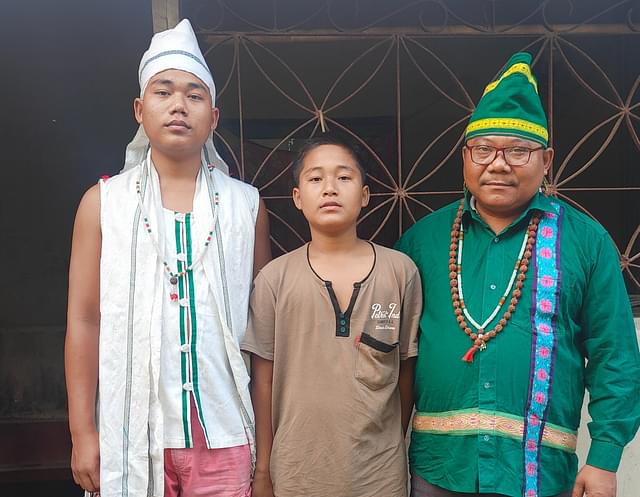
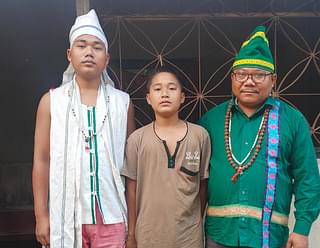
Consumption of beef, cats and monkeys is strictly banned, as is consumption of alcohol and drugs. Smoking cigarettes, though allowed, is frowned upon and discouraged.
First time violators are punished with excommunication from the Mandali for a few days or weeks. Community elders monitor the conduct of the punished person and if he or she shows sufficient remorse and seeks forgiveness, the punishment is revoked.
The punishment for second time offenders is stricter — excommunication for at least two months, social boycott and frequent public reprimands by community members. A second-time offender has to undergo counselling by community elders and seek pardon from ‘Monu’.
Only after ‘Monu’ and the dharmagurus are satisfied that the offender has mended his/her ways is the excommunication lifted.
Third-time offenders are permanently excommunicated from the Mandali and under no circumstances will they be taken back.
Thankfully, says Jatindra Reang, it has not been necessary to take such an extreme step against anyone. “All offenders repent and mend their ways after the first time only. Barely a handful repeat their mistake and have to be punished again,” he said.
Members of the Ram Mandali are also expected to adhere to certain social norms. “Using abusive language is not allowed and aggressive behaviour is censured. Parents are encouraged to instil Sanatani values in their children from a very early age,” said Reang.
Respect for elders, obedience and dutifulness among children is rewarded. The Mandal encourages children and young adults to participate in sports to foster team spirit and a sporting spirit among them. Sports events form an integral part of religious gatherings.
Charity is an enshrined duty and members of the Mandali are expected to share their food and wealth with their less fortunate brethren.
Premarital sex is frowned upon and cohabitation by unmarried couple is censured. Arranged marriages are encouraged and, says Jatindra Reang, is usually the norm.
Only arranged marriages, called uttam vivahas, are solemnised in the mandirs. ‘Love’ marriages and weddings of couples who had engaged in premarital sex are disallowed in the Ram mandirs.
Religious And Community Gatherings
Attendance at community and religious gatherings is mandatory. All members of the community, for instance, have to participate in bhajans-kirtans at the mandirs four times a week: Tuesday evenings, Wednesday mornings and evenings and Saturday evenings.
Rituals are conducted according to the guidelines and procedures laid down in the two books written by ‘Monu’. These books also contain the lyrics for the bhajans-kirtans, and the ceremonies to be conducted for weddings.
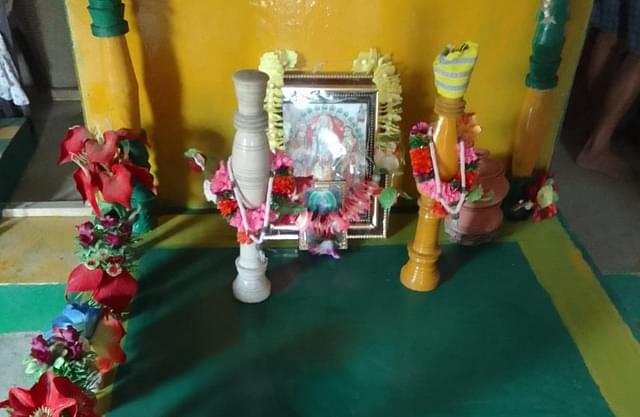
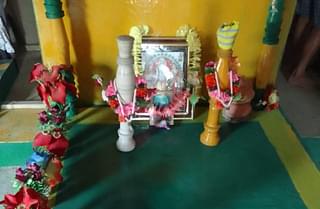
‘Sanatan Boishu’, the main annual festival of the sect, is held during Poush Sankranti (usually in mid-January every year). The religious heads of the sect choose one particular Ram mandir for this and all members of the sect gather there.
“Bhajans-kirtans and religious discourses are held on the three days. There are community feasts and games also,” said Reang.
Another major festival is the Lakshmi Puja, called ‘Mai Nowk Ma Sal Ktor’ in Bru. This is spread over four days, but is held in all the Ram mandirs.
There is a separate festival for the young members of the community. A three-day annual congregation for the youth is held every year and draws hundreds of young men and women. Debates and discussions on Sanatan Dharma are held and apart from ‘Monu’, senior leaders of the sect also deliver discourses.
Why Such Codes Are Important
Jatindra Reang explains that a social order (samaj vyavastha) and parampara are important. “Our parampara and sanskriti sets us apart from the followers of foreign faiths and we have to protect our heritage, culture and traditions,” he said.
“Encouraged by the church, (Tripuri) militants had tried to denigrate our parampara and said that the rituals and customs that govern Sanatan Dharma had kept us backward. They banned our religious practices and used to torture our people who practised Sanatan Dharma openly.
“But ultimately, militancy is dead and we prevailed. The militants and their sponsors — the Christian missionaries — could not defeat us. That is because Sanatan Dharma is strong. Today, we are bringing back all those who were led astray and had converted to Christianity,” said Reang.
However, he added, ‘Monu’ realised that the “best way to preserve and propagate Sanatan Dharma and safeguard our faith from future onslaughts by missionaries and their agents is to get ourselves organised well”.
“This has made us stronger as a community and deepened our faith in Sanatan Dharma,” Reang added.
The Satya Sanatan Dharma Mandal is now planning to convert itself into a formal trust and start working among the other tribal communities of the state to propagate Sanatan Dharma among them. And, also, to get back those who converted to Christianity among other tribes into the Sanatan fold.
Save & read from anywhere!
Bookmark stories for easy access on any device or the Swarajya app.
Support Swarajya's 50 Ground Reports Project & Sponsor A Story
Every general election Swarajya does a 50 ground reports project.
Aimed only at serious readers and those who appreciate the nuances of political undercurrents, the project provides a sense of India's electoral landscape. As you know, these reports are produced after considerable investment of travel, time and effort on the ground.
This time too we've kicked off the project in style and have covered over 30 constituencies already. If you're someone who appreciates such work and have enjoyed our coverage please consider sponsoring a ground report for just Rs 2999 to Rs 19,999 - it goes a long way in helping us produce more quality reportage.
You can also back this project by becoming a subscriber for as little as Rs 999 - so do click on this links and choose a plan that suits you and back us.
Click below to contribute.

